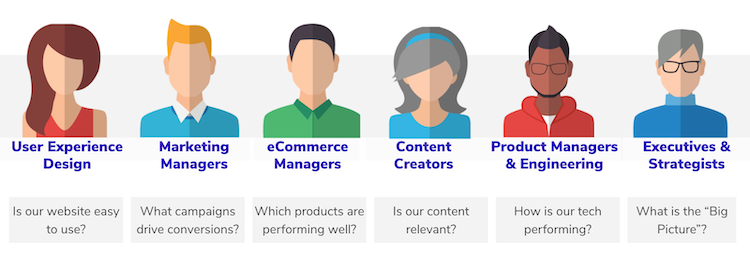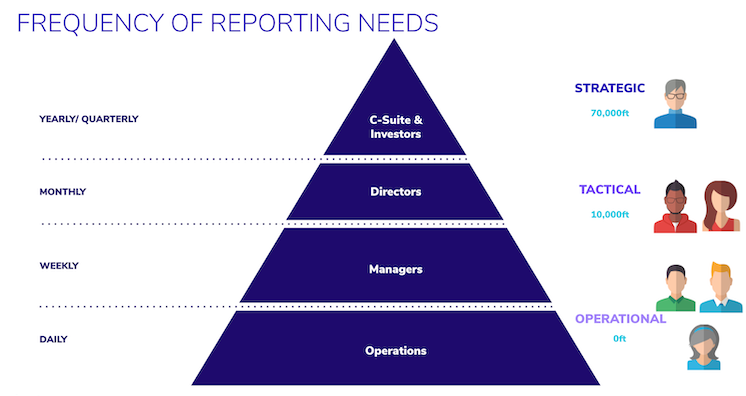Serving Strategic Reports to Internal Stakeholders

Like most digital platforms, web and mobile analytics have continued to evolve and prioritize customization. If you're using a tool such as Google Analytics, Adobe Analytics, or Snowplow, chances are you’ve been collecting numerous events and conversions to better understand how users interact with your website and mobile application. Such depth and breadth of data open the door to several analysis and reporting opportunities that are undoubtedly valuable to your company; kudos to your work thus far!
However, an abundance of data often can be overwhelming when we start to devise a reporting strategy. Several common questions that we ask prior to sharing digital data may include:
- “What should I report on?”
- “Who should see this information, how often, and when should I engage them?”
- “If I send this to a team, what will they do with the information? Will this be actionable?”
- “Are these users going to understand my digital metrics and the associated value?”
One very powerful way to derive a reporting strategy that can check the box of each common question above is developing internal personas (or recipients) of our reporting. Developing personas will ensure that we provide the right information to the right people (at the right time!). So, let’s explore how we can drive internal team member’s attention towards metrics that matter for their area of expertise.
What Are Internal Personas?
Platforms like Google and Adobe Analytics are excellent resources for analyzing the actions that users take on our website, but they can also be used to organize and present Key Performance Indicators (KPIs) to internal users (personas) in a succinct way.
Internal personas (stakeholders) are fictional categories of professionals within your organization. They represent the distinct groups of people that you are attempting to share data, insights, and performance trends. Said differently, personas enable us to isolate the consumers of our reports, providing them with relevant information and a pleasant user experience.
Some common personas that you may have within your organization include:
- User Experience Designers
- Marketing Managers
- Commerce Managers
- Content Creators
- Product Managers & Engineering
- Executives & Strategists
Each internal persona will have KPIs that are specific to their job function and needs. For example, some stakeholders in Marketing or commerce functions will be interested in activities like campaign performance, while Product Managers and Engineers will be heavily involved in measuring website/app performance and speed. These distinct groups will also require information at a unique cadence, where some prefer daily, weekly, monthly, or even quarterly updates.
Developing KPIs for Internal Personas
Now that we have a list of common internal stakeholders, let’s explore each of these individuals and teams in more detail. We’ll list out a few common questions that you may get from your internal stakeholders, and provide a few reports in Google Analytics that you can use to answer those questions.
The questions and solutions we provide below are just a start, but you’ll notice that they often result in additional analysis opportunities. This is a good thing! A report should give the end-user information, but enable them to ask more questions to find the right solution or approach.
User Experience Design
Because User Experience (UX) team members spend significant time researching the actions and behaviors of your customer base, UX personas will be primarily concerned with how users engage with the website and if they find what they need. They may also want to know if people feel comfortable when navigating the site and if the site communicates how the company can help customers (or businesses if your site is B2B).
There are numerous reports in Google Analytics or Adobe Analytics that we can use to better understand website usage, navigation, and self-service success. Some common questions from User Experience designers and associated reports in Google Analytics are:
| Question Posed | Analysis & Reporting Solutions |
|---|---|
| Which pages are visited the most? | Use the “All Pages” Report and Content Groups. Are there any trends that arise? Are some pages visited more frequently by individual segments? |
| Which Call to Actions (CTAs, or “click here” buttons) draw the most attention? | Enable event tracking for CTAs, and report on pages where the CTA is most used with a secondary dimension. You can find this in Google Analytics under the Behavior > Events > Pages report as well. Are some CTAs missed completely? Could these pages be redesigned? |
| What are the key entrance & exit pages? | Use the Landing & Exit page reports in Google Analytics, trended over time. Are entrance and exit pages consistent? |
| How do users interact with our navigation? Site Search? | Enable event tracking for Navigation. Implement site search tracking. Report on usage over time. Are there navigation elements that are used heavily, while others not at all? Are some search terms so common that they may be valuable as navigation elements? |
| What language preferences are used? | Report on changes in languages over time using the Audience > Geo > Language reports in Google Analytics. Should we develop websites that are translated to another language? |
| How much time do people spend on our site? | Trend Avg. Session duration, and verify if recent UX updates impact this metric over time. Are people spending too much time on self-service sections that should be expedient? How can UX help? |
| How active are our users? | Analyze & trend Pages/session, bounce rate, interaction events for all users, or specific segments. Do we see changes in these groups? Are users getting less active? |
| What is the retention rate? | Trend returning vs. new users over time. Are we losing returning users in specific segments more than others? |
| Which pages or CTAs contribute to conversions? | Enable event tracking for CTAs as a segment, and apply to the “Goals Overview” reporting. Are there CTAs that can be added to more pages to increase conversions? |
Marketing Managers
The Marketing Manager stakeholder can mean many different things to many people. In this definition, Marketing Managers are responsible for managing a combination of digital campaigns including paid and unpaid, remarketing activity, email campaigns, distribution lists, and lead generation.
We can think of this persona as our inbound specialist, or the individual who is trying to attract new customers to our site and engage returning customers to continue business with us. This stakeholder will be interested in acquisition metrics, campaign performance and return on investment (ROI), lead generation influence, and landing page conversion metrics. They will also be interested in user behavior metrics as they relate to campaigns or attribution.
There are several dimensions and metrics that we can use to better understand lead generation and campaign performance. Some common questions for Marketing Managers include:
| Question Posed | Analysis & Reporting Solutions |
|---|---|
| Which campaigns are performing well? (Acquisition, Goal Conversion, Return on Investment) |
|
| Which channels are performing well? | Review Source/Medium reports, and trend channels that are contributing to conversion metrics over time. Isolate any channels with high and low conversion rates, and determine if there are any common threads. |
| How are we doing with generating leads? | Ensure event tracking is present for all form submission or contact opportunities. Tie back these events and/or goal conversions to marketing initiatives (landing pages, campaigns, SEO, etc.). Additionally, consider investing in integrations between lead generation tools like HubSpot, Marketo, Salesforce, etc. |
| Are users responding well to our targeted landing pages? | Review time on page for landing pages and Event tracking for CTAs to move users from landing pages to the website. Monitor the goal and conversion rate by landing page. |
Commerce Managers
If you offer the sale of goods or services on your website or mobile application, chances are that your organization has a department dedicated to commerce management.
Regarding digital analytics efforts, commerce stakeholders will be interested in how users interact with products, including impressions and transactions. They will also be curious to see where drop-off occurs in the check-out flow, including adding or removing items from a user's cart.
| Question Posed | Analysis & Reporting Solutions |
|---|---|
| Which products are performing well? (Quantity, Revenue, Repeat Purchases) |
Using the “Product Performance” page in Google Analytics, review the product performance over time. Analyze quantity sold compared to overall revenue within the portfolio. Create segments to determine if certain product categories drive repeat sales, suggesting brand loyalty. |
| Which channels drive the most revenue? | Review acquisition reports, isolating channels that steadily contribute to revenue over time. Are there any underlying reasons these channels perform better than others that we can replicate? |
| How is our impression to purchase rate? Product detail page to purchase Rate? | Ensure commerce tracking is in place for each metric. In Data Studio or within a calculated field in Google Analytics, apply the rates to individual SKUs to determine overall performance. Rates are useful here as they will determine overall success regardless of quantity, giving us a metric to review over time. |
| Where do people drop off in the check-out process? | Ensure commerce check-out steps are in place, and view the “Checkout Behavior” funnel in Google Analytics. |
| How do people interact with the items in their cart? | Analyze the product add to cart and remove from cart events over time. Use the Product Performance List report for insights into how lists impact carts. |
| Which content lends a hand in the purchase? | Create segments for purchasers vs. prospects, and isolate any pages that seem to play a part in transactions. |
Content Creators
Websites and mobile applications are filled with content surrounding your product, service, company, and overall objectives. Whether centralized as a corporate group, or spread out within each business unit, it is highly likely that there are select individuals responsible for developing website messaging and tone.
Content Creators will want to analyze how the content that they generate is performing, and if the topics are increasing conversions. They may be interested in if users jump between topics, or if they spend more time reading specific content compared to the site-wide average.
| Question Posed | Analysis & Reporting Solutions |
|---|---|
| Which pages and types of content are viewed the most? | Using the “All Pages” Report and custom Content Groups, determine if there are any trends that arise. Are certain content groups always viewed in conjunction with others? Is there a correlation between viewing content pieces? |
| What types of pages are interacted with in a session? | Use content groups within segments to see if you find any trends. Try out a sequence segment to test a hypothesis that users move from content group x to group y. |
| What are the key entrance & exit pages? | Use the Landing & Exit page reports in Google Analytics, trended over time. See if these pages contribute to conversions (goals). |
| What are users searching for? | Use site search (and search terms) to uncover if you need to create new content to answer a question, or fill a gap within the site. These terms can also inform keyword building. |
| How much time do people spend on each page? | Trend Avg. time on page to see if users are reading or simply skimming the content. For important, lengthy content, implementing Scroll Tracking events can be useful to see how far a user reads each article. |
| Are people watching our videos? | Use Event tracking videos, and see if users are consuming the full-length or quitting early. |
Product Managers & Engineering
Many Digital Product Managers or Application/Web Developers are not only responsible for the performance of the website/application, but often the new features that are released to encourage retention, lead generation, or other KPIs. Because their functions span product functionality and conversion rates, these internal personas will be interested in understanding the product’s performance (where product is the app, website, or new feature on a site), and how the product contributed to a conversion. Segmenting behavior by device, browser, operating system, or simply feature usage and influence will also be desirable.
| Question Posed | Analysis & Reporting Solutions |
|---|---|
| Which web or app features are performing well? (Overall Usage, Usage over Time, Conversion Influence, Return on Investment) |
|
| Which devices, browsers, OS are performing well? | Review the technology reports for any anomalies regarding devices, browsers, and OS. Optimize new products for common browsers and device combinations. |
| How about site speed? | Review the page timings and speed suggestions reporting. Determine if you can optimize any slow-loading content/images. Create and apply segments to see if these pages are negatively impacting conversion rates. |
Executives & Strategists
Our last internal persona is concerned with each element from above (user experience, acquisition, content performance, development efforts, and commerce data), but often at a very high level. More explicitly, executives and strategists will be concerned with the bigger picture, such as how key initiatives are performing relative to expectations. They also may be interested in high-level site and application trends and conversion metrics.
For execs, display the most important information first, and give context! Try not to overwhelm these users with the detailed actions that it took to achieve the results, but give them information that they can use to guide next steps.
| Question Posed | Analysis & Reporting Solutions |
|---|---|
| How does the website impact our organization’s revenue? (Commerce Revenue, Lead Generation, Conversion Influence) |
|
| How are Key Initiatives on our site impacting our business? | For example, if you recently invested in a new site platform, conducted a hiring campaign, were given budget $ to conduct an SEO audit and overhaul, implemented a new landing page software, or upgraded your CRM, you’ll want to report on the success of these large, corporate-wide outcomes.
|
Reporting Tools & Methods
With so many reporting opportunities for each vertically defined persona, it’s important to maintain clear, concise reporting. This includes developing actionable and to the point visualizations, adding context where your personas will need it, and sending reports at a pre-defined cadence, with an opportunity for dialogue and reflection.
Developing Reporting & Adding Context
We’ve all been sent dashboards and reports that, while visually appealing, do little to inform us. Ensuring that your visualizations are free of clutter, easy to understand, and draw the user’s eye to the right information is just as important as identifying the right metrics and dimensions.
In addition to keeping things simple and to the point, adding textual context to your reports can help your personas understand key points. For example, you may want to highlight an anomaly that you’ve discovered, or a particular segment that you’d like to highlight.
Moreover, don’t be afraid of summarizing this month’s findings in the email that gets sent with the dashboard. Users often need a helping hand to uncover trends, insights, and key takeaways that will help them make positive business changes. Even better than an email? Consider holding a 30-minute review call where you give users the opportunity to have a direct dialogue with you about the data.
Reporting Cadence
In addition to key metrics, each persona may require information at a unique cadence. For example, content managers may need up-to-date reports about their most recent publications more often than a strategist.
As a rule of thumb, managers of these areas may require weekly and monthly reports, whereas executives may only need to be informed monthly or quarterly. But be sure to discuss these report cadences with your end-users as you onboard them to your internal reporting packages.
Final Thoughts
Google Analytics or Adobe Analytics is a great way to serve important and actionable insights to internal personas. Because these platforms are common systems of record, they can be trusted for all internal users. Moreover, data capture for these platforms can be tailored for specific actions that each internal team cares about, making our reporting even more informative.
However, you may also have access to additional internal data sources that can add context or provide more granular detail. For example, marketing managers may desire reports that contain KPIs for Ad platforms and campaign managers or social and video platforms. Your business may also maintain internal commerce platforms, databases, and other source systems that have rich data. These data sources may be relevant to numerous personas including commerce managers, digital product managers, and executives.
Merging outside metrics may provide more context for the users, and should definitely be evaluated when you feel that you are ready!




